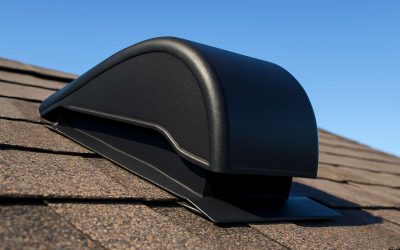
When your roof isn’t properly ventilated, it can cause problems like roof leaks, mold and mildew in your home. However, the good news is that there are a variety of solutions to remedy this issue, and one of the best ways to get your home’s attic venting right is to install new roof shingles with built-in ventilation holes. These vents help your roof stay cool and healthy throughout the year.
The Basics
Ventilation is important because it allows hot air to escape from your attic space and cool, fresh air to enter your living spaces. A properly vented attic helps keep your house cool and comfortable, even on the hottest days of the year, and it also reduces your energy costs.
There are a few different types of roof vents to choose from, each designed to offer specific benefits. To make the most of your roof ventilation, it’s best to use both intake and exhaust vents for optimal results.
Exhaust Vents
Hot air naturally rises from your attic, but it can be stubborn when trying to leave. This is where exhaust vents come in handy – they help to “bounce” the hot air out of your attic space. Exhaust vents can be installed in a variety of ways, including ridge vents and gable vents.
Ridge Vents
A popular choice among roofing companies, ridge vents are a great option for homes with flat or low-pitched roof construction. During installation, a gap is cut into the ridge cap of your roof and a flexible ridge vent shingle is bent over and nailed in place. These shingles are usually made from a color that blends in with the rest of your roof, making them nearly undetectable to the naked eye. Additionally, ridge vents are designed to withstand snow loads and other weather conditions that may prevent the operation of other venting styles.
Gable Vents
Similar to ridge vents, gable vents are another popular roofing option and they’re also built into the shingles. They are positioned on the lower side of your attic, taking in air from the underside of your roof and forcing it out through the peak. Often times, gable vents are combined with eaves vents to provide the full benefits of roof ventilation.
Intake Vents
Intake vents, which can be a combination of many types of roof ventilation systems, work with your attic’s exhaust to ensure that your attic stays cool and dry. Intake vents can be found in a variety of places, but they are most commonly installed in soffit areas or at the fascia or drip edge of your roof. They’re typically long and thin in shape to match the shingles of your roof, and they are available in a number of colors to seamlessly blend into your attic’s design.
Powered exhaust vents, which are typically electric or solar-powered, turn on automatically when they detect that the attic temperature has reached a certain level. They then run until the attic temperature drops, providing your home with a continuous flow of fresh air.



0 Comments